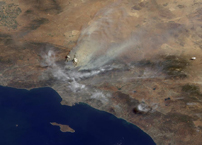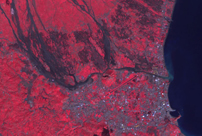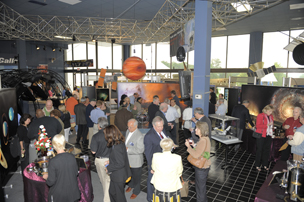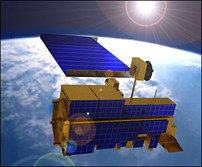Archive
Highs and Lows from Ten Years of Terra, Flagship of the NASA Earth Observing System
Change, as the old saying goes, is the only constant thing in the universe. Just over a decade ago, NASA launched a satellite called Terra to watch Earth’s surface and atmosphere. How is the planet changing and what are the consequences of change for life down here?
Last week, the Terra folks at Goddard held a private bash at our Visitor’s Center to celebrate Terra’s many accomplishments to date. Here are some of the various highs and lows of the mission that caught my eye:
HIGH: On December 18, 1999, Terra blasted off to a typical Earth-observing orbit 435 miles above the surface . . . It is 22 feet long and 11.5 feet wide, or about the size of a small school bus. Did I mention it weighed 5 tons (10,506 lbs) at launch at Vandenberg Air Force Base? . . In contrast, its high-tech lightweight solar panel weighed just 371 pounds because it was made up of solar cells fixed to a flexible blanket that unfurled in orbit. (Thanks to Eric Moyer, EOS Mission Director, for looking up that blogolicious science fact about Terra.)
LOW: Millions of people grounded in Europe by drifting ash from Iceland’s (deep breath) Eyjafjallajokull Volcano. On May 13, Terra’s MODIS instrument observed the irritatingly unpronounceable volcano mixing it up with a local weather system.
HIGH: Terra’s CERES instrument package measures how much solar energy Earth absorbs and how infrared radiation and heat is emitted back into space. Such sky-high measurements mean a lot for us puny groundlings, since Earth’s “energy balance” affects global climate.
LOW: Terra told us that gases and particle that drag down air quality can be Asian imports transported long distances by the wind. The MOPITT instrument on Terra sniffs out carbon monoxide; the MODIS and MISR gizmo’s track tiny aerosol particles. Both carbon monoxide and aerosols influence air quality.
 HIGH: Terra’s MISR instrument showed that large wildfires inject particles ands gases high into the atmosphere. This enables the smoke to drift long distances. For example, smoke from the high-flying plumes of the 2009 Station Fire drifted as far as Nevada, Utah, and Colorado. Carbon monoxide from the fire traveled at least as far as Louisiana.
HIGH: Terra’s MISR instrument showed that large wildfires inject particles ands gases high into the atmosphere. This enables the smoke to drift long distances. For example, smoke from the high-flying plumes of the 2009 Station Fire drifted as far as Nevada, Utah, and Colorado. Carbon monoxide from the fire traveled at least as far as Louisiana.
 LOW: Terra’s ASTER instrument has proven a valuable tool for imaging mudslides, a notoriously murderous natural hazard sometimes unleashed by the combination of volcanic ash eruptions and heavy rainfall. In this image captured December 12, 2006, mudslides are black against a red background of plant-covered land. The populated towns Legazpi and Daraga are gray with white highlight from reflective surfaces.
LOW: Terra’s ASTER instrument has proven a valuable tool for imaging mudslides, a notoriously murderous natural hazard sometimes unleashed by the combination of volcanic ash eruptions and heavy rainfall. In this image captured December 12, 2006, mudslides are black against a red background of plant-covered land. The populated towns Legazpi and Daraga are gray with white highlight from reflective surfaces.

Scientists and supporters of the Terra mission whoop it up at the Goddard Visitor Center.
Gogblog gratefully tips his blogolicious hat to Kathryn Hansen and Mike Carlowicz from NASA’s Earth Science News Team for their detailed account of Terra’s scientific accomplishments, from which much of this blog post was adapted.
_____________________________________________________________________________________________________
OH AND DID I MENTION? All opinions and opinionlike objects in this blog are mine alone and NOT those of NASA or Goddard Space Flight Center.
//
</p> <div><a href=”http://www.w3counter.com” mce_href=”http://www.w3counter.com”><img src=”http://w3counter.com/tracker.php?id=39986″ mce_src=”http://w3counter.com/tracker.php?id=39986″ style=”border: 0″ mce_style=”border: 0″ alt=”W3Counter” /></a></div> <p>

